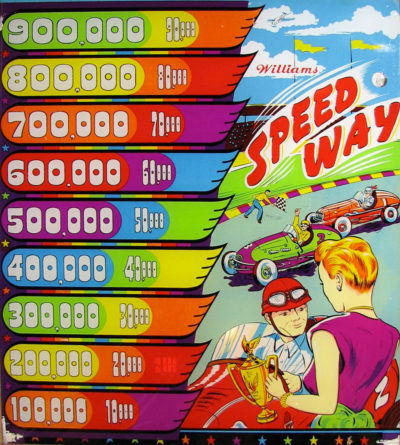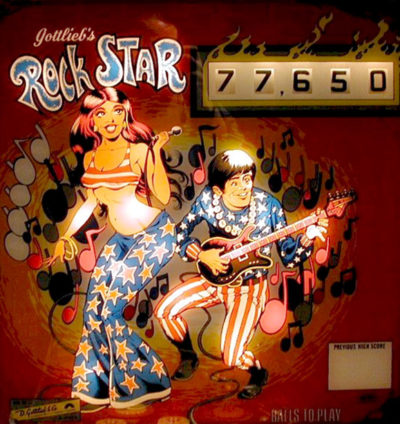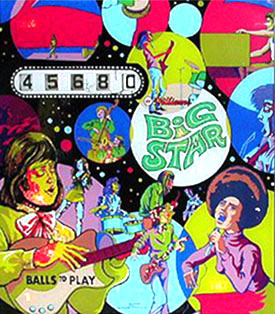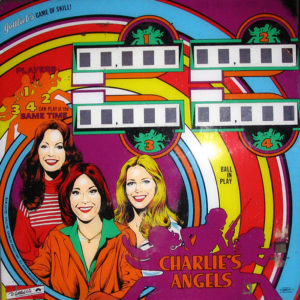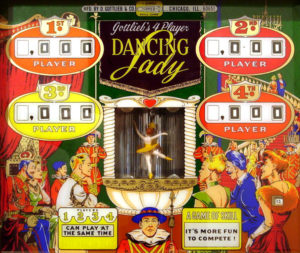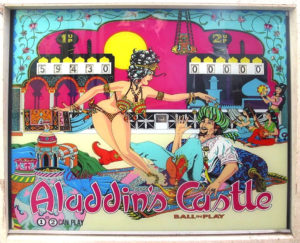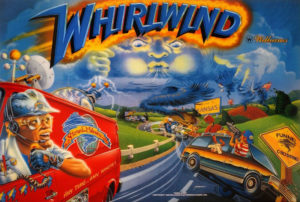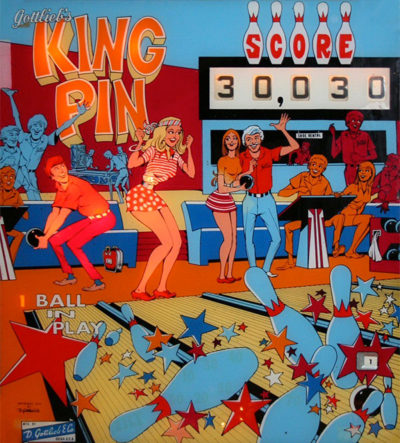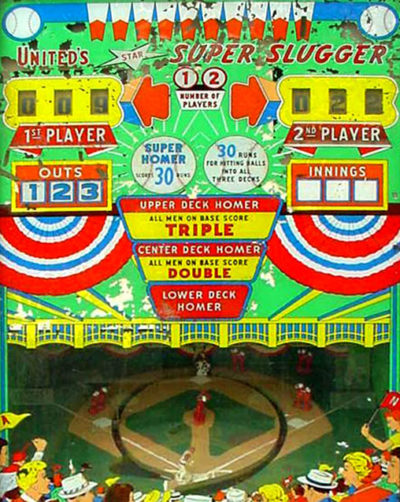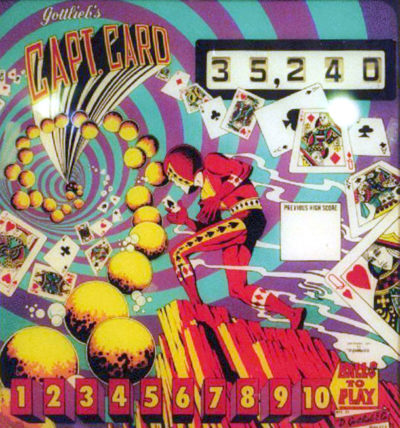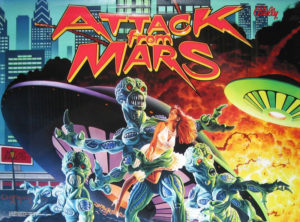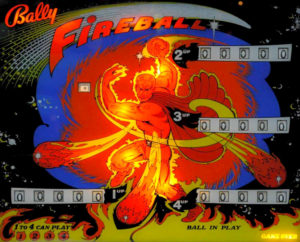-
The game before you is extremely rare with only 278 screwed together at the Chicago Gottlieb factory. This one-player electromechanical add-a-ball game was designed by John Osbourne with art by Gordon Morison. A replay version was also designed by the name of Blue Note. The object of this machine is to complete all the notes down the left side of the playfield. Doing so activates the classic “wow” feature which, when hit, awards one free ball. A reset is in your future once your current ball drains. Score is another way to achieve longer play by winning extra balls. The spinner in the middle of the playfield awards big points when 1,000 points is lit; each spin of the target awards 1,000 points plus number of revolutions spun. A nice retro art package completes this rare machine.This one-player September release was designed by Steve Kordek with art package laid out by Christian Marche. 1,130 units were made, which is a pretty low production run. This is an add-a-ball game with a replay version also released called “Superstar.” This machine incorporates not one but three pop-up posts to deflect the ball from draining through the side drains as well as the flipper drain. The object of the machine is to extend your playing time by winning more free balls. This is achieved by completing the s-u-p-e-r roll-overs at the top of the play field. Doing so lights the hidden center kick-out hole. By dropping the target in front of this hole, one has a shot at the extra ball prize. If both specials are lit, two free balls are awarded. Completing each five-star sequence also advances the center shot award. Score is another to earn extra balls per game. Replay games were much more popular back in this era, but not every locale allowed replays.This four-player machine was produced in November of the year with 2,675 units fabricated. It was designed by Ed Krynski with art penned by Art Stenholm. Technically, a couple of firsts were incorporated into this machine for Gottlieb, like an automatic ball lifter, decagon score reels and carousel roto-targets. The carousel roto-target allow one to shoot at one or two targets at a time if flipper savvy. The star on the unit awards an extra ball. The object of the game is to achieve high-enough scores to award replays. The big points are awarded when the two 10x lights under a roto-target light up, awarding 100 times the value of the number hit. The most attractive gadget built into the game is the dancing ballerina in the backglass, which dances when certain elements of the play field are achieved. A highly collectible game in its own right.June marked the month when Bally let Greg Kmiec and Christian Marche unveil their newest creation to the pinball world. This two-player game awards an extra ball when the A-B-C-D sequence is completed. C and D when completed, award the double bonus. The third flipper in the middle right of the playfield gives the player maximum control to shoot for the Aladdin’s Alley. Hitting the rollover at the top of this shot scores the lit value and then advances the value for the next completed shot. If you’re skillful enough to make it to the 5,000 shot, the next shot scores a special. This special remains lit for the balance of the ball in play. All in all, a typical Bally game of the era. This game was released at the same time as the classic Captain Fantastic Bally machine (that game is in the museum). Captain Fantastic made Bally #1.This machine was produced in january and 7300 copies of it were bolted together. Pat lawlor designed the game with john youssi penning the artwork. The earliest machines in the production run had the chicago cubs logo on the child’s baseball cap but the cubs disallowed its use so the logo was changed. The early examples had a williams logo sticker over the cubs logo. The object of the game is to advance the compass to the north, south , east and west positions. Doing so starts ball lock ..And the “power of the wind” through the use of a dedicated fan on top of the machine to recreate a new physical dimension to your gameplay. Once three balls are locked, the left ramp awards increasing million awards. By earning enough tolls, extra balls may be had. The super cellar value changes via the spinner. Dropping into the cellar awards its value. Another “twist“ in the game’s design is the spinning discs. Tornado action.This massive baseball “pitch and bat” game is considered one of the best baseball games of its era. One or two players could play this behemoth at once, with each player alternating for three innings of play for a nickel or dime. The pitcher may randomly press one of three pitch buttons to pick a weak-to-strong pitch to the batter. The open play field allows one to try and score a home run in one of three bleachers. If you can achieve getting a homer in all three bleachers during your three outs, 30 extra runs are awarded. Then, of course, the ultimate tag of the ball would land the ball in the super home run hole, a rare achievement. This would also award 30 extra runs. Another unique feature of United baseball machines is the scoring of three singles if the ball drops in front of the ramps. These games are also notorious for having a slew of “out” holes. Batter up!May was the release month for this game. Designer Ed Krynski and artist Gordon Morison put together the package. Production run was low, at 675 units. This is an add-a-ball game variant, the replay version was called High Hand. The challenging part of this playfield design is trying to lock a ball in the eject hole for extra balls. Four batteries of drop targets in four colors are along the sides of the playfield. Making a completion of a color of drop targets increases the value of the eject and side drains. If all the drop targets are completed, the extra ball features light up. Score is another way to win balls set by the operator. No match units were incorporated into these games as, again, that was considered a form of gambling, i.e. winning a free game.This four-player machine is almost always considered to be in the top five best solid-state games of its genre. Brian Eddy designed this machine with art by Doug Watson. 3,450 examples of it were made. This fast-paced game is not based on the “Mars Attacks” movie but ironically came out the same time as the movie’s release. A sequel to this game is also in the museum by the name “Revenge From Mars.” The main theme of this amusing game is to complete the five attack waves activated by hitting the three drop targets in front of the saucer. Doing so drops the targets and allows shots to the saucer. After so many saucer hits, the saucer explodes into a flurry of strobe lights (first time used on a pinball machine) and sounds. If you make it to Mars Attacks, the game goes into hyper mode with a flurry of options and actions. Total annihilation of Mars is the ultimate goal. Many more feats and multi-balls are also present.This is it. The ultimate collectible game of the ‘70s according to the literature. Bally put together Ted Zale and Dave “Mad Dog” Christianson to design the game. Production run was 3,815 units. Many firsts here. The whirlwind spinning disk was a first to throw off the ball once rolled upon. A messenger ball (captive ball) was a variation on a theme. The art package is truly amazing. A lower-left kick-back kicker, when activated, returns your ball to play. A free ball gate returns your ball to the plunger. “Zipperflippers”, a first, closes the gap between the flippers, when activated, preventing the loss of the ball thru the center drain until turned off. Once you lock two balls in the “odin” and “wotan” kickout holes, then hit “release messenger balls”, three balls are in play. No jackpot in multiball in this game was developed. You just had a period of high scoring and pinball chaos to contend with until you lost the first two balls in play.



